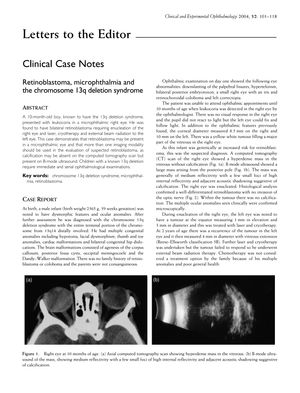Clinical Case Notes: Retinoblastoma, Microphthalmia, and Chromosome 13q Deletion Syndrome
February 2004
in “
Clinical and Experimental Ophthalmology
”

TLDR The document concludes that careful diagnosis is crucial for chromosome 13q deletion syndrome, tamoxifen can cause reversible eye damage, finasteride may be linked to cataracts, and OCT is useful for diagnosing macular diseases.
The document presents three clinical cases: the first case is of a 10-month-old boy with chromosome 13q deletion syndrome diagnosed with bilateral retinoblastoma, emphasizing the need for multiple imaging modalities in diagnosis, especially in children with this syndrome. The boy, now 7 years old, suffers from profound growth and mental retardation and a complication of radiotherapy. The second case involves a 68-year-old woman with tamoxifen-induced toxic optic neuropathy, which improved upon cessation of the drug, highlighting the need for awareness of this potential side effect in patients with visual impairment on tamoxifen therapy. The third case suggests a possible association between finasteride, used for hair loss, and the development of anterior subcapsular lens opacities, a type of cataract, in a patient without dermatological findings typically associated with ectodermal disorders like alopecia. The document also briefly mentions a case of Castleman's disease and discusses the use of OCT in diagnosing Adult-onset Foveomacular Vitelliform Dystrophy, demonstrating its usefulness as a diagnostic tool for macular and retinal diseases.
